The best time to travel to Morocco depends largely on what you want to experience: desert, cities, coast, or perhaps mountains? In principle, you can travel to the country year-round—but not every region is suitable for every season.
April, May, October, and November are ideal for tours and city trips. In summer, it often gets extremely hot in the interior and in the desert—up to over 40 degrees Celsius. The Atlantic coast with places like Essaouira or Agadir remains pleasant even in July and August thanks to the sea breeze – perfect for a beach or surfing holiday.
In this article, you’ll get a clear overview of when each region and activity is particularly worthwhile – without a lot of fuss, but with everything you really need to know. Enjoy browsing!
- Morocco’s climate at a glance
- Spring in Morocco
- Summer in Morocco
- Autumn in Morocco
- Winter in Morocco
- Monthly overview
- Best time to travel to the Sahara
- Best time to travel to Marrakech & The Imperial Cities
- Best time to visit the Atlantic coast
- Best time to visit the Atlas Mountains
- Best time to visit Morocco by activities
- Holidays in Morocco
- Morocco during Ramadan
- Morocco’s best time to visit – frequently asked questions
- Best time to visit Morocco – our conclusion
Morocco’s climate at a glance
Morocco has a very diverse climate. Coastal regions such as Essaouira or Agadir offer a mild, Atlantic climate, while cities such as Marrakech or Fez can get extremely hot in the summer. And then, of course, there are the High Atlas and the Sahara – two completely different worlds. The best time to travel to Morocco varies depending on the region and climate zone.
Climate zones roughly summarized:
- Coast (e.g. Essaouira, Agadir): Mild, pleasant year-round, but also windy.
- Central Morocco (Marrakech or Fez): Very hot in summer (often over 40 °C), mild in winter, but cool at night.
- Atlas Mountains: Ideal hiking climate in spring and autumn, snow in winter!
- Desert (e.g. Merzouga): Brutally hot in summer, pleasant during the day in spring and autumn, freezing cold at night in winter.
Spring in Morocco
For us, spring (March to May) is the best time to travel Morocco. The temperatures are pleasant in almost all regions – not too hot, not too cold. At this time of year, you can travel through the country in a relaxed manner and see many great sights in Morocco – without heat stress or weather chaos.
The landscape is particularly beautiful at this time: green valleys, blooming almond trees, clear views in the mountains. You can also go hiking in the Atlas Mountains now – it’s not too hot yet, and the paths are mostly easy to walk on.
Conclusion on Spring
- Climate: Pleasantly warm, sunny, little rain | 20–30 °C, depending on the region
- Great for: Round trips, sightseeing, hiking, desert
- Highlight: Blooming landscapes & Ideal travel weather
- Tip: Book early, especially around Easter, it fills up quickly!
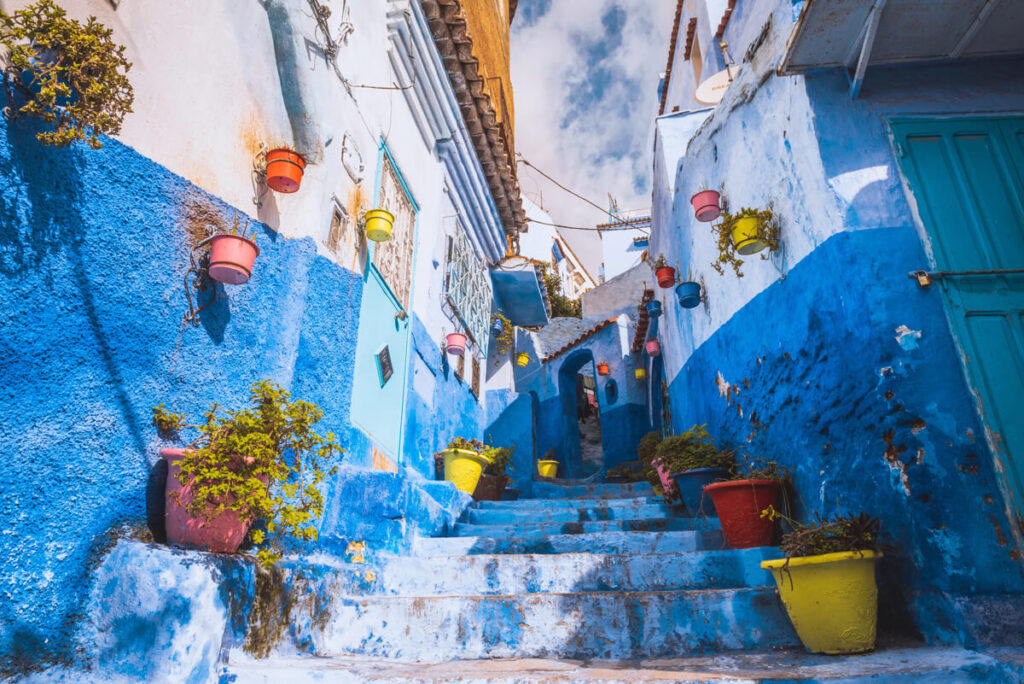
Summer in Morocco
Summer (June to August) is hot – really hot. Especially in the interior and in the desert, temperatures quickly rise above 40 degrees Celsius. City trips to Marrakech, Fez, or the desert at this time are really only for those with a heat tolerance. Things are different, of course, on the Atlantic coast. In places like Essaouira, Taghazout or Agadir, it is pleasantly warm in summer, but never unbearable – thanks to the fresh breeze from the Atlantic.
If you want to travel to Morocco in summer, it’s best to stay on the coast or in the mountains – and plan your activities for the early morning hours.
Conclusion about summer
- Climate: Very hot inland & in the desert | 25–45 °C, milder on the coast
- Best for: Beach holidays, surfing, Atlantic coast
- Highlight: Perfect weather for beach days with an Atlantic breeze
- Tip: Plan activities for the early morning or evening
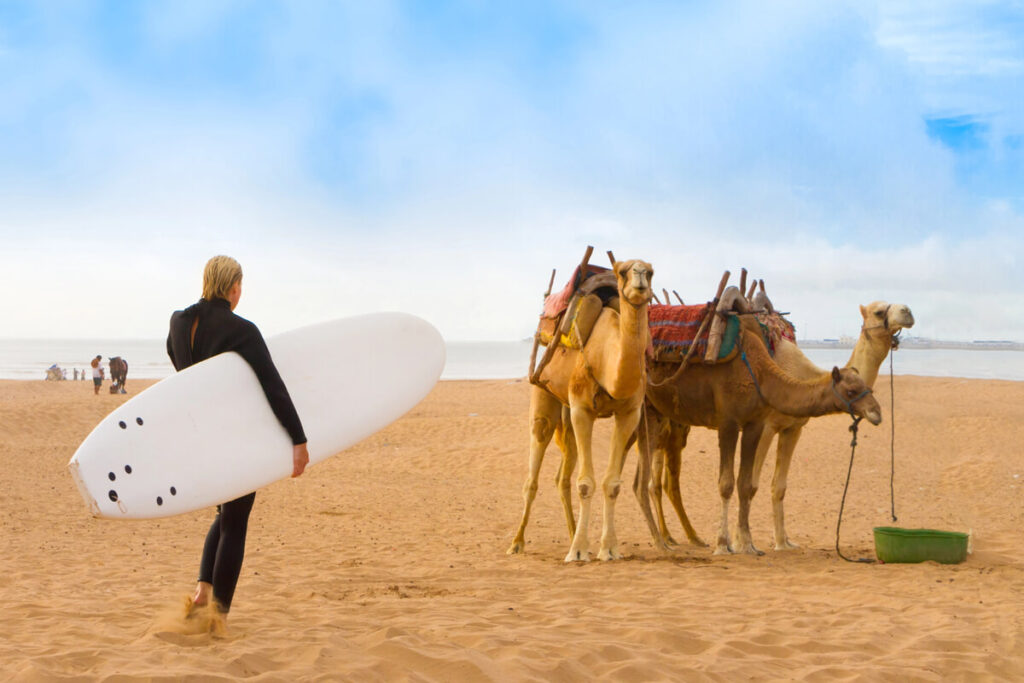
Autumn in Morocco
Autumn (September to November) is a really great time to travel to Morocco. The intense heat of summer is over, but it’s still warm enough to travel through the country in a relaxed manner. The desert is finally worth it again; in Marrakech, you can stroll through the alleys for hours without melting away, and even the sea is still pleasantly warm.
Autumn is also ideal for hiking in the Atlas Mountains – the light is beautiful, the colors vibrant, the temperatures just right. If you’re flexible and want sun without the hustle and bustle, autumn is the perfect time for you in Morocco. Fewer people, great conditions, and a perfect break from the gray autumn weather at home.
Conclusion on Autumn
- Climate: Warm & dry, mostly sunny | 22–32 °C
- Best for: Round trips, desert, cities, hiking
- Highlight: Golden colors, clear views & Pleasant temperatures
- Tip: October is the perfect all-round month
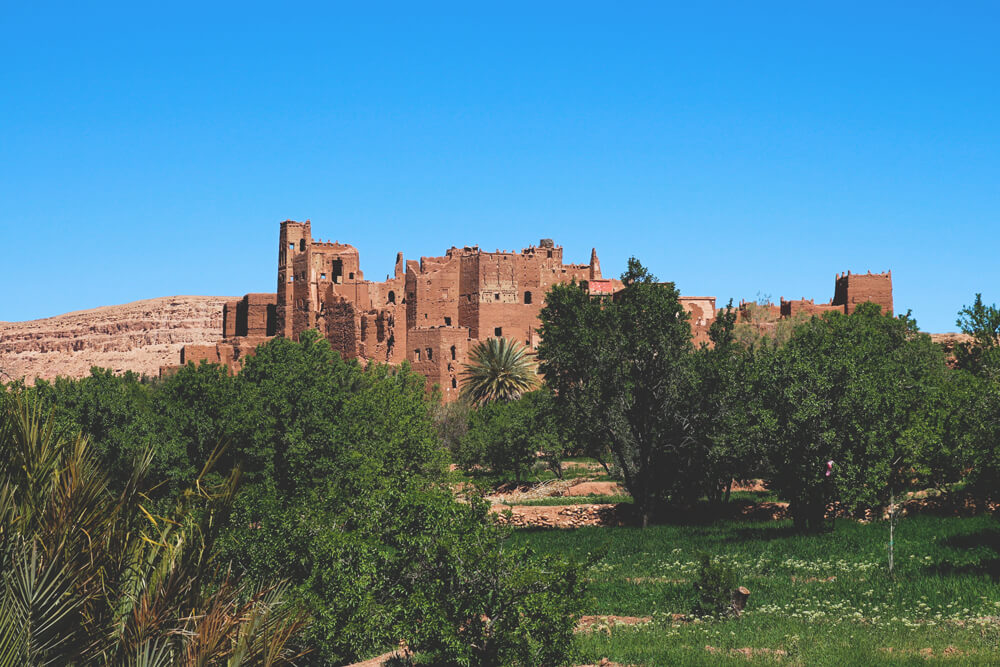
Winter in Morocco
Winter (December to February) is a great time to travel – if you like mild temperatures, prefer sightseeing without the heat, and don’t feel like mass tourism. Winter is particularly pleasant for cities and tours. In Marrakech, Fez, and other inland cities, you can often expect 18 to 21 degrees Celsius and plenty of sunshine during the day.
However, it can get chilly in the mornings and evenings – especially in riads without heating. Layering is recommended. On the Atlantic coast (e.g., in Agadir or Essaouira), it remains mild, but it can be windy and occasionally rainy. Winter there isn’t really suitable for a classic beach holiday, but it’s still nice for walking and relaxing.
In the Atlas Mountains, there’s even snow in the higher elevations – perfect for snow lovers (Tip: Oukaïmeden and Ifrane ski resorts). However, some areas around Toubkal are only accessible to a limited extent during this time. And in the Sahara? Mostly wonderfully sunny during the day, but really icy cold at night. A night in a tent is still possible – but only with warm clothing and, ideally, several thick blankets.
❄️ Conclusion for winter
- Climate: Mild to cool | 17–21 °C in cities, cold nights in the desert
- Great for: City trips, quiet coastal visits, hiking at low altitudes
- Highlight: Few tourists, clear air & relaxed atmosphere
- Tip: Warm clothing for the evenings & Don’t forget the desert nights
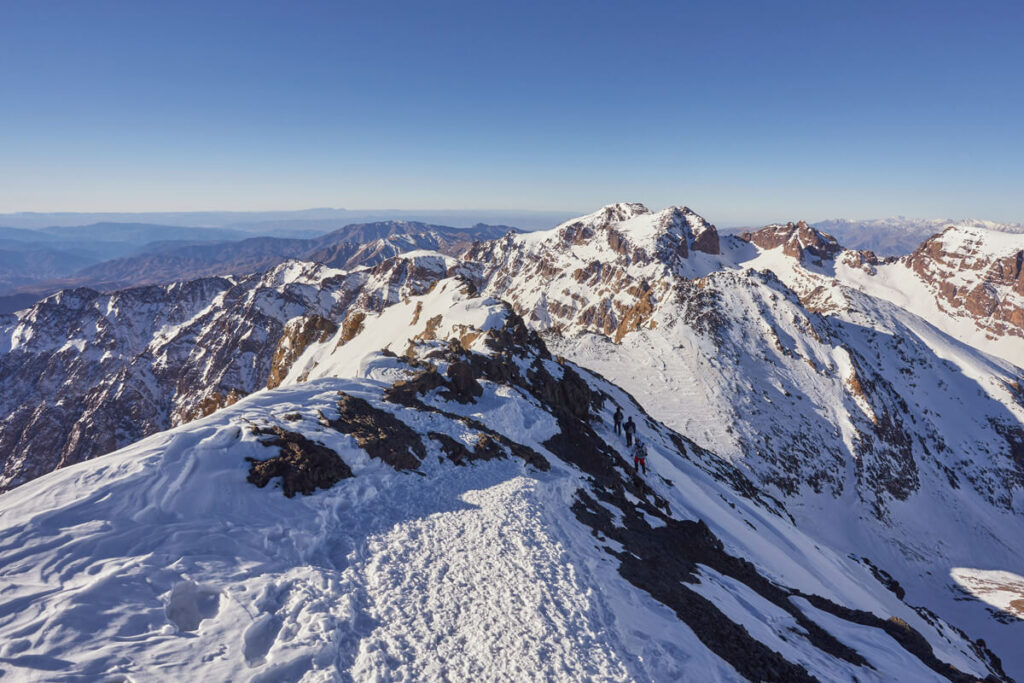
Monthly overview
Which is the best month for a trip to Morocco? There is no general answer to this question. However, if you’re planning a round trip—i.e., combining different regions such as cities, the coast, the desert, and the mountains—you should pay particular attention to pleasant temperatures and a minimum of extreme weather.
The best months for a Morocco round trip are: March, April, May, October, and November. During this time, it’s not too hot in the interior of the country, and the desert isn’t yet sweltering. Sunny days with pleasant temperatures await you on the coast, and the Atlas Mountains are also ideal for excursions and hikes.
Best time to travel to the Sahara
The Sahara is one of the absolute highlights in Morocco – endless dunes, clear starry skies, and absolute silence. However, the conditions there are extreme, especially regarding temperatures. If you’re planning a desert tour, for example, to the Erg Chebbi Desert, the Erg Chegaga Desert, or the Agafay Desert, you should choose your travel time carefully.
The best time to travel to the Sahara is in spring (March to May) and autumn (October to mid-November). During the day, it’s pleasantly warm, but not too hot, and you can really enjoy tours, horseback riding, or overnight stays in a tent.
In winter (December to February), you can often expect a mild 20 degrees Celsius during the day – perfect for exploring. However, at night, it can get icy, sometimes below zero. We even spent the night in the desert and were very glad we had thick sweaters and jackets with us – it can get really uncomfortable in a tent.
Summer (June to August) is absolutely not recommended for the desert. Temperatures rise to over 40 degrees Celsius, sometimes even 50. Many tours then only start early in the morning or late in the evening to avoid the midday heat. In addition, sandstorms are more frequent during this time – not a particularly pleasant experience, as other travelers have reported to us.
Our conclusion about the Sahara:
- Recommended travel time: March to May & October to mid-November
- Avoid: June to August – too hot, too strenuous
- Also possible: December to February – with warm clothing
Climate table Sahara (Merzouga, average temperatures)
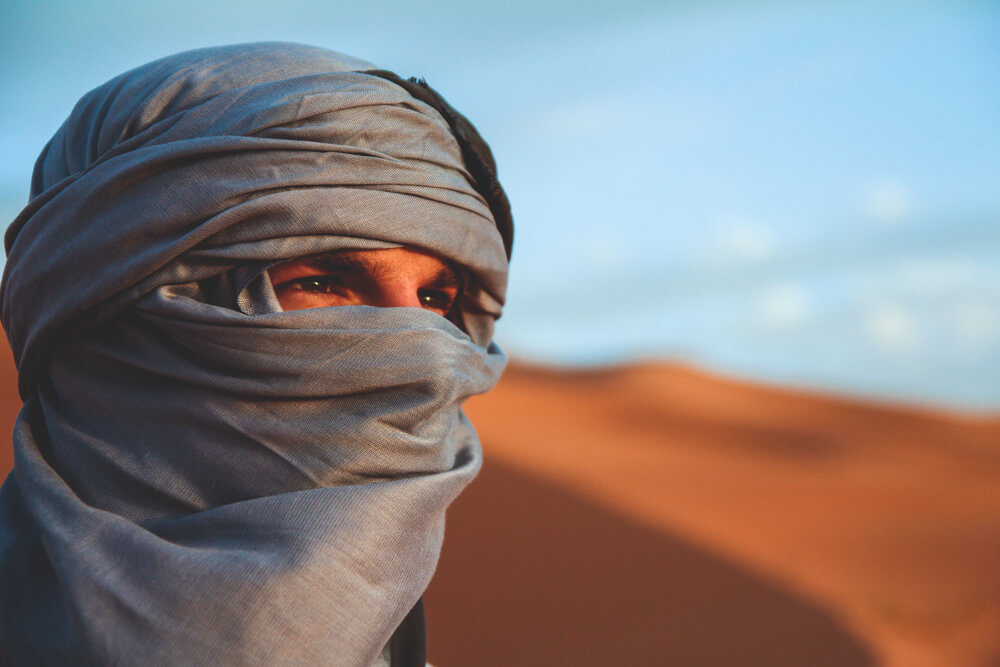
Best time to travel to Marrakech & The Imperial Cities
Cities like Marrakech, Fez, Meknes, or Rabat are best explored in spring and autumn. Then the climate is pleasantly warm, quite dry, and perfect for city strolls, markets, and relaxing evenings on the roof terrace.
Marrakech has a warm, dry climate year-round. However, in the summer months, it can get extremely hot – with temperatures over 40 degrees Celsius. Sightseeing then quickly becomes a sweltering experience. The months from June to September are therefore less recommended. If you don’t mind high temperatures, there’s still nothing wrong with traveling during this time.
The best months for a city trip are March, April, May, October, and November. We were last there in March and April and had great weather: Daytime temperatures were a pleasant 20 to 21 degrees Celsius, with an average of only 6 to 7 rainy days per month.
- Recommended travel time: September to May
- Avoid: July and August – even in the mornings it’s often over 30 degrees Celsius
- Fun fact: Many riads and cafés are empty in the afternoons in summer – it’s too hot. It only comes alive again in the evening.
Climate table Marrakesh (average temperatures)
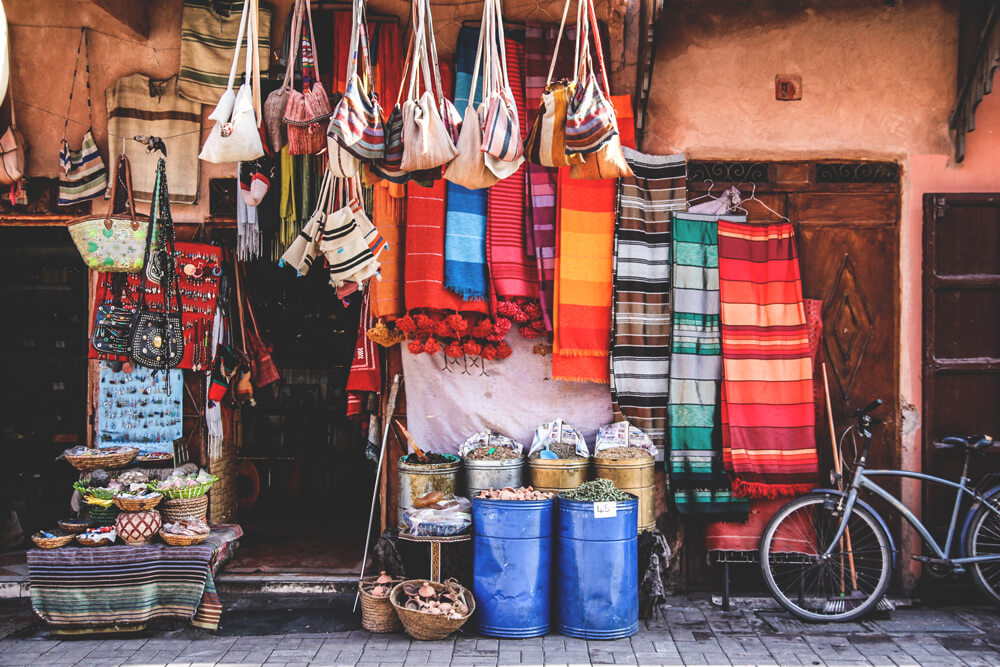
Best Time to Travel to the Atlantic Coast
Morocco has two coasts: In the north lies the Mediterranean coast with places like Tangier and Nador, and in the west stretches the Atlantic coast with cities like Rabat, Casablanca, Essaouira, Agadir, and Taghazout. Both coasts have a mild Mediterranean climate, with pleasant temperatures year-round.
The best time to travel to the coastal regions is from April to November. During this time, you can expect summer temperatures, hardly any rain, and up to 10 hours of sunshine per day – perfect conditions for a relaxing beach holiday. In summer (June to September), temperatures are pleasantly warm at 26 to 28 degrees Celsius, but never too hot thanks to the sea breeze. July and August are the warmest and driest months—ideal for swimming and soaking up the sun.
In winter (December to February), temperatures on the Atlantic coast are generally mild, with daily temperatures around 17 degrees Celsius, but it can be windy and occasionally rainy. Swimming is less popular then – but if you just want to relax or take long walks on the beach, you’re still in good hands.
- Recommended travel time: April to November – sunny, dry, and pleasantly warm
- Avoid: December to February – mild, but often windy and sometimes rainy
- Note/Tip: The best waves are in winter, especially around Taghazout.
Climate table Essaouira (average temperatures)
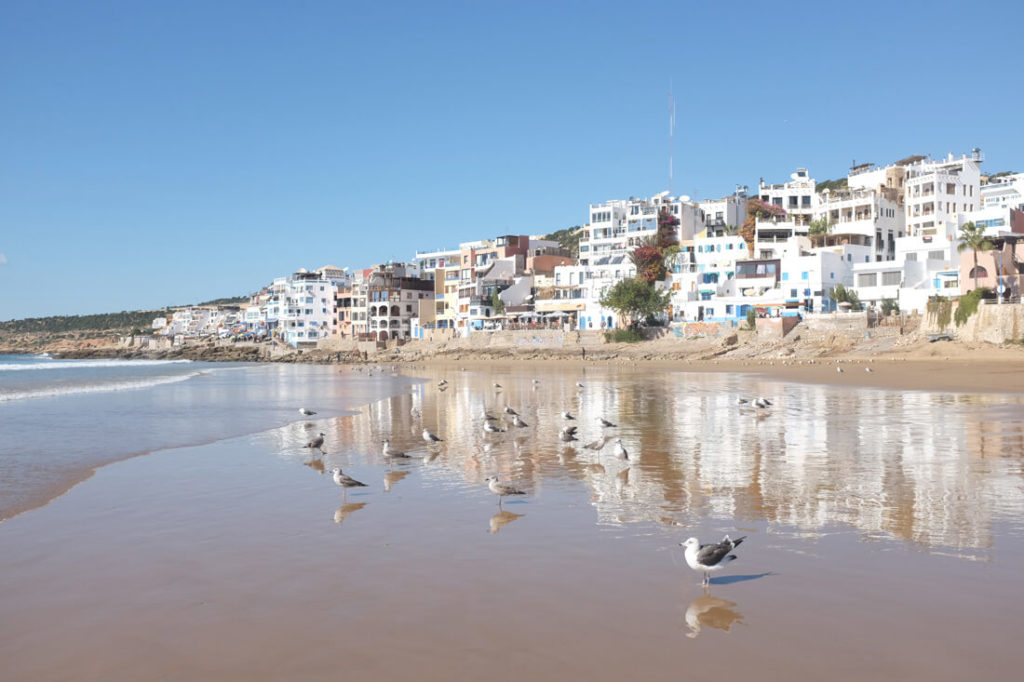
Best time to travel to the Atlas Mountains
If you like hiking or just want to get out of the city If you want to, a detour to the Atlas Mountains is definitely worth it. The impressive mountain landscapes are perfect for nature lovers, active vacationers, and adventurers – but the climate there is very different from the rest of the country.
Due to the altitude, it is significantly cooler in the mountains and there is more precipitation – both rain and snow. While we were still able to wear a T-shirt in Marrakech in April, we needed a thick sweater and rain jacket in the Atlas. Conditions can therefore vary greatly depending on the region and altitude.
The best time to travel to the Atlas Mountains is from March to May and from September to November. Temperatures are pleasant for hiking then, the paths are generally easy to walk on, and the landscape is particularly beautiful. Excursions to Ait Ben Haddou, the Dades Gorge, or the Todra Gorge are also most fun in spring.
- Recommended travel time: March to May and September to November
- Avoid: December to February and June to August
- Note: Start the day early and check the current conditions on site – many accommodations know the best routes depending on the weather.
Climate table Aït Ben Haddou (average temperatures)
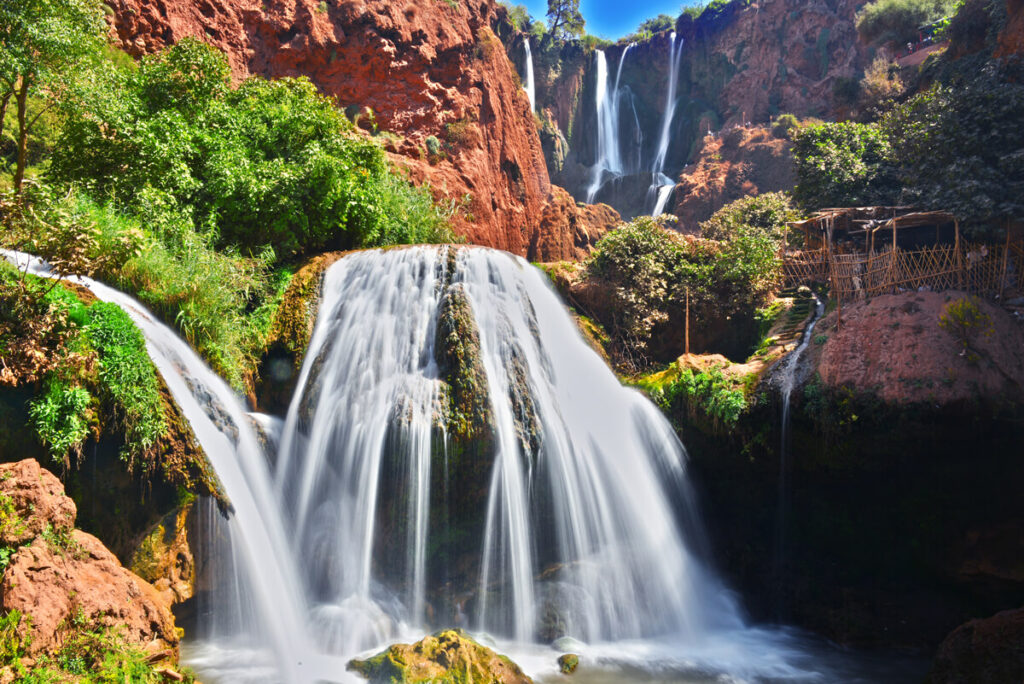
Best travel time Morocco by Activities
The best time to travel to Morocco depends largely on what you want to experience in the country – whether you want to stroll through imperial cities, spend the night in the desert, surf, or hike. Here you’ll find an overview of when each activity in Morocco is most worthwhile.
Public Holidays in Morocco
In Morocco, just like in Germany, there are of course public holidays and school holidays, but don’t worry: they shouldn’t disrupt your travel plans. Most sights and museums are usually open on public holidays.
On religious holidays such as Eid al-Fitr, the cities become significantly busier. At the same time, it’s also a great opportunity to experience the special atmosphere and the hustle and bustle on the streets.
You should pay more attention to the Islamic holidays: During Ramadan, for example, things are often quieter during the day. Many restaurants don’t open until the evening, and public transport may also be limited.
Our tip: If you’re flexible, this isn’t a problem. If you’re planning tours or transfers, it’s worth taking a quick look at the Moroccan holiday calendar beforehand.
Important Holidays in Morocco
- January 1st – New Year
- January 11th – Independence Day
- May 1st – Labor Day
- May 14th – Anniversary of the Founding of the Army
- May 23rd – National Day
- July 30th – Throne Day (Accession of Mohammed VI)
- August 20th – Revolution Day (King & People)
- August 21st – Youth Festival
- November 6th – Anniversary of the Green March
- November 18th – Independence Day
- Eid al-Fitr: Festival marking the end of Ramadan
- Eid al-Adha: Feast of Sacrifice, approximately 70 days after the end of Ramadan
Morocco during Ramadan
Once a year it is Ramadan – the month of fasting in Islam. It is a very special time in which you can experience Morocco in a completely different way. It’s quieter, slower, and at the same time more intense – but you should know what you’re getting into. Exactly when Ramadan begins depends on the sighting of the crescent moon. Ramadan then lasts about 29 to 30 days and ends with Eid al-Fitr (the festival of breaking the fast). Many restaurants and cafés are closed during the day, especially outside of tourist centers. Street food stalls usually don’t open until late afternoon. There’s less going on in the cities, but it can get quite quiet in smaller towns. It’s also not uncommon for tourist attractions to close for one to two hours during the day. It’s best to organize snacks or a small breakfast in advance if you’re out and about – you won’t find something to eat at lunch everywhere. In the evening, however, everything changes: When the fast is broken, the squares fill up, the scent of freshly baked goods fills the air, and people eat together everywhere. A truly amazing experience!
What you should know:
- Don’t eat or drink in public during the day, especially not in small towns – out of respect.
- Plan your excursions so that you’re back “home” before sunset – taxis and buses often run less frequently.
- Tours and opening hours may be limited – it’s worth checking in advance.
☞ Our conclusion: You can travel to Morocco during Ramadan without any problems – it’s actually particularly exciting. However, if you want to travel as smoothly as possible, traveling outside of Ramadan is probably the more relaxing choice.
Morocco’s Best Time to Travel – Frequently Asked Questions
Spring (March–May) and autumn (September–November) – ideal weather for tours, sightseeing, and the desert.
In January and February – fewer tourists, cheaper accommodations, many good deals.
On the coast, pleasant with 26–28°C, inland and in the desert often over 40°C.
Between November and February – especially in the north and in the Atlas Mountains.
January – especially at night it gets chilly, especially in the mountains and in the desert.
On the Atlantic coast around Essaouira, Taghazout, and Agadir – rough, wild, and still perfect for chilling.
July and August, if you You don’t tolerate heat well – especially in the interior and the desert.
It’s rather cool on the Atlantic coast – possible, but not for frostbitten people. Ideal for beach walks and surfing.
Best time to visit Morocco – our conclusion
The best time to visit Morocco depends heavily on your destination and your plans. Spring and fall are almost always a good choice – especially if you want to see a lot. Summer on the coast is also a good time for a beach holiday. And for desert tours or hikes, plan well, choose the right time of year – and then just set off.
- Blue City of Chefchaouen by Kotangens
- Surfing in Taghazout by kasto
- Snow on Toubkal by saharrr
- On the beach in Taghazout by DorSteffen
- Ouzoud Waterfalls by monticello